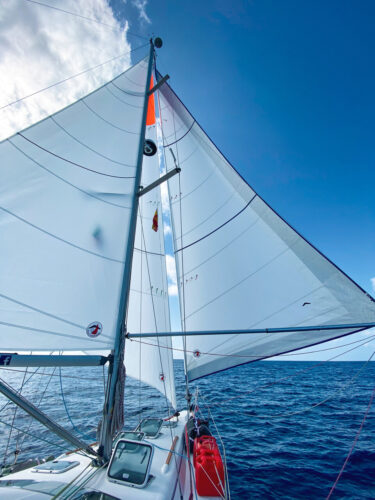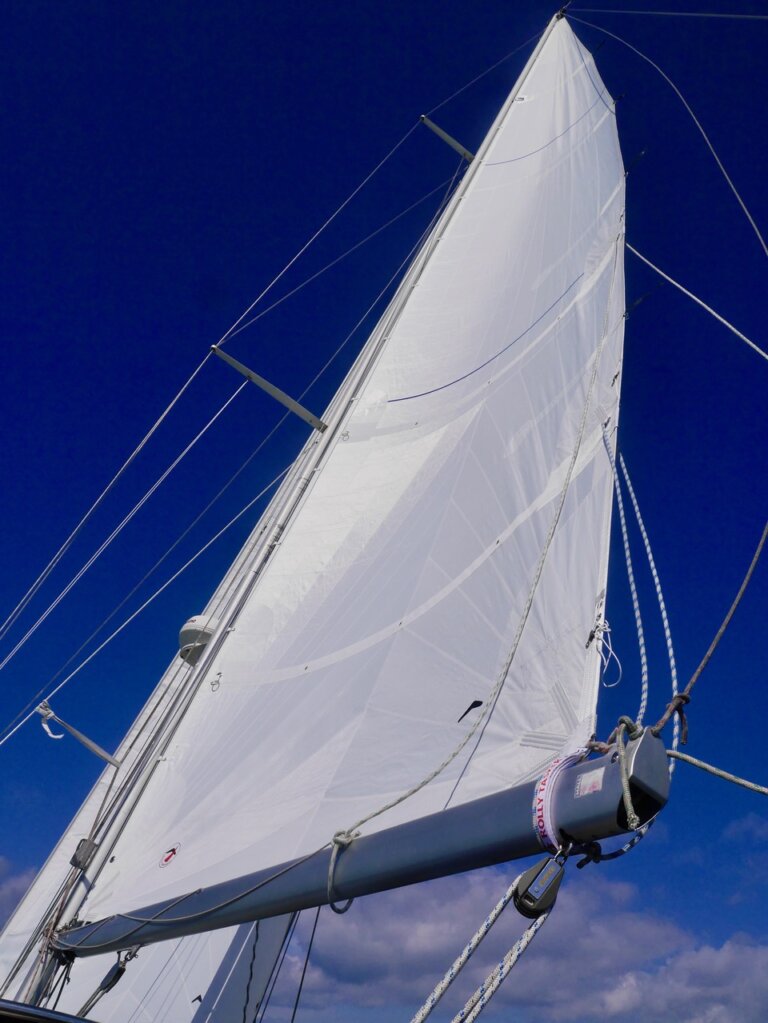In this guide, we’ll explore how in-mast furling systems work, their benefits, potential challenges, and key tips for smooth operation and maintenance.
Why Choose an In-Mast Furling System?
In-mast mainsail furling makes handling of the sail easy for the short-handed crew or single cruising sailor. Like a furling Genoa, the mainsail is rolled for reefing and dowsing, but in this case, inside the mast. And once it is furled, there is no need to flake the mainsail on the boom and cover it or close the lazy-bag as the sail will stow itself away in the mast automatically. The clew of the sail that stays outside the mast when fully furled is protected by our UV-protection cloth Sunbrella.

Key Considerations Before Choosing In-Mast Furling
Some masts or furling systems have more or less room in the mast profile to furl the sail. Limited space will restrict the choices of sail cloth and design.
For example, if space is limited, it may not be possible to choose a radial sail design or a fully battened in-mast furling sail.
Pros and Cons of Adding Vertical Battens to an In-Mast Furling Sail
Vertical Battens can be used to increase roach of the sail and thus performance. These would commonly be full-length, vertical battens. These slim and well-designed battens do not add too much thickness to the furled sail and are very reliable and trouble-free. Sometimes, also short, non-overlapping battens are used. But either way, too much roach will make furling difficult, and so it will always be less than on a “conventional” sail.
Both types of battens are seen by some dedicated ocean voyaging sailors with a critical eye as potentially being able to block the furling operation. The recommendation here is to have a furling main without any battens which, if well designed, will still set fine.
How to Properly Operate Your In-Mast Furling Mainsail
Furl the sail firmly and tight without creases to avoid possible problems when unfurling. Make sure that the outhaul line cannot get stuck in its jammer. When furling, keep some tension on the outhaul. It is important to find the correct balance here. Too much tension will put too much load on the sail and the bearings of the furling gear. Not enough tension, on the other hand, will cause the sail to not be furled tight enough.
If the sail gets jammed during furling, unfurl the sail until it is free, then pull the sail tight on the roller foil inside the mast. To do this, hold the outhaul and roll up the sail again a bit, keeping the outhaul well under tension. If necessary, repeat this manoeuvre several times.
Furling by Hand vs. Using a Winch
As with a Genoa furler, the in-mast mainsail furling should be operated by hand. If a winch is needed, then this is a clear indication that there is a problem somewhere. The extra torque applied to the furler through the winch will only make matters worse in a short term and put too much load on the bearings and furling foil. On some big boats, the furler is driven by a hydraulic or electric motor, in which case the crew needs to be even more careful.
Common Issues & Troubleshooting: What To Do If Your Sail Gets Jammed
One common issue is too much mast bend. The mast should be as straight as possible for the system to work smoothly. Likewise, if the mainsail halyard is set up too tight it can cause the sail to throw horizontal folds and these then also get jammed. Rarely does it happen that the furling profile in the mast is too loose and has to be tensioned. Another problem could arise from damaged ball bearings of the furler.
Old sails which are stretched and worn out will become “baggy” and then tend to get stuck inside the mast.
Routine Maintenance for Long-Lasting Performance
Regular maintenance of the system should include checking the main components including foil, bearings, swivel, and gear box. The same goes for the running rigging consisting of furling line, outhaul and halyard that may have to be replaced from time to time. Also removing the salt from the moving parts and also the blocks of the lines from time to time.
In-Boom Furling vs. In-Mast Furling Mainsail
In-Boom Furling is basically the same principle as in-mast furling, but now inside the main boom. With this system, it is essential to strictly operate with the right mast/boom angle. If the angle is not correct, there is a risk of the luff tape being damaged or pulled out of the groove on the mast, or the groove itself being damaged. This system is used mainly on big boats using a strong hydraulic boom vang on which this angle can be controlled precisely.
Professional Rigging Services in Phuket
Apart from designing and making the new sail, Rolly Tasker Sails can offer a comprehensive service when deciding for an in-mast furling system including rig tuning, furler inspection and servicing, running rigging replacement, installation, and removal of the sail. This can be arranged with our own rigging team at the Rolly Tasker Sails headquarters in Phuket, or with the help of your local Rolly Tasker Sails dealer or representative in your area.

Upgrade Your Sailing with a High-Quality Furling Mainsail
Make sail handling easier and more efficient with a custom in-mast furling mainsail from Rolly Tasker Sails. Designed for durability and performance, our sails ensure smooth furling and reliable operation. Discover our furling mainsail options today!







